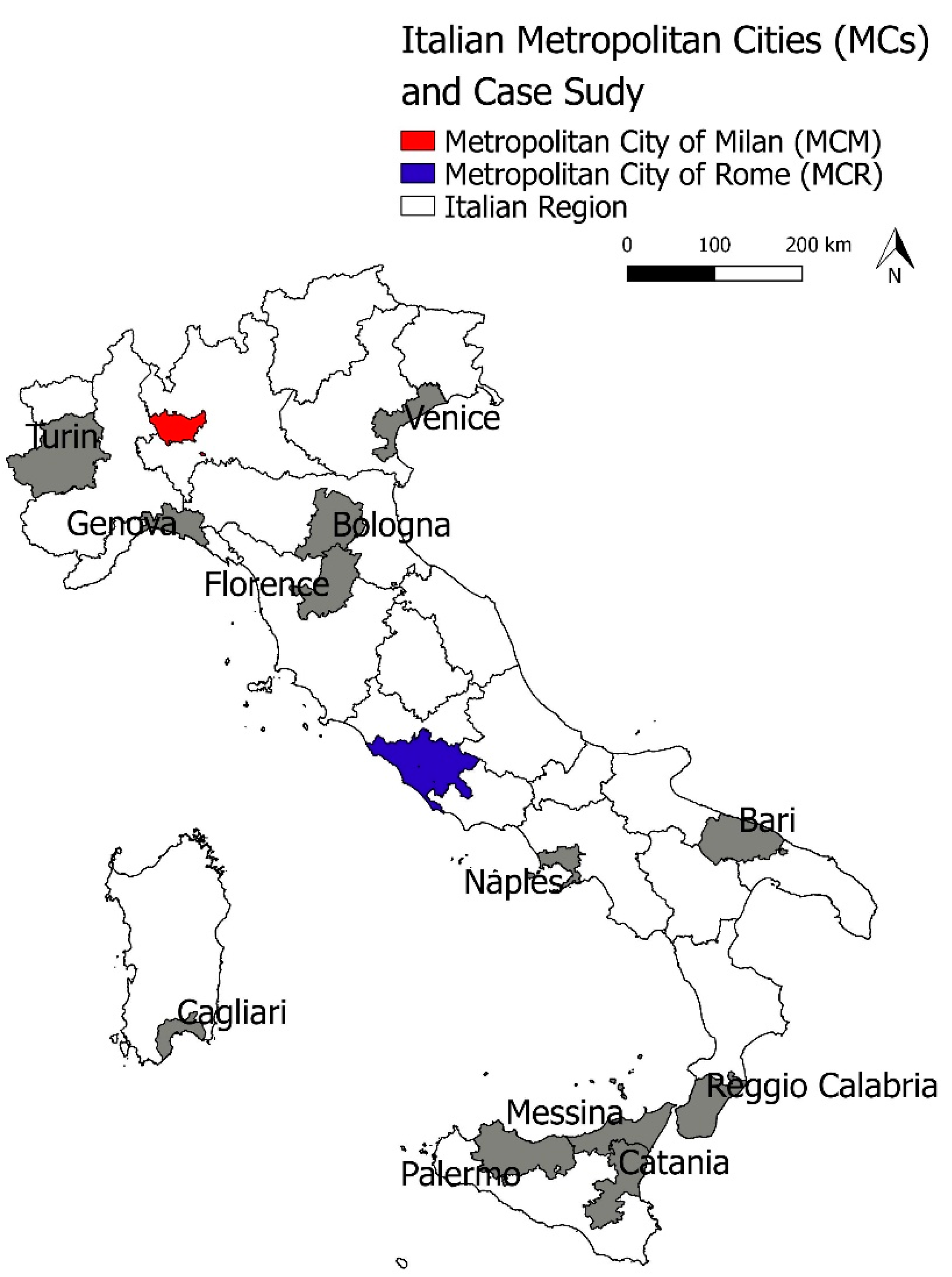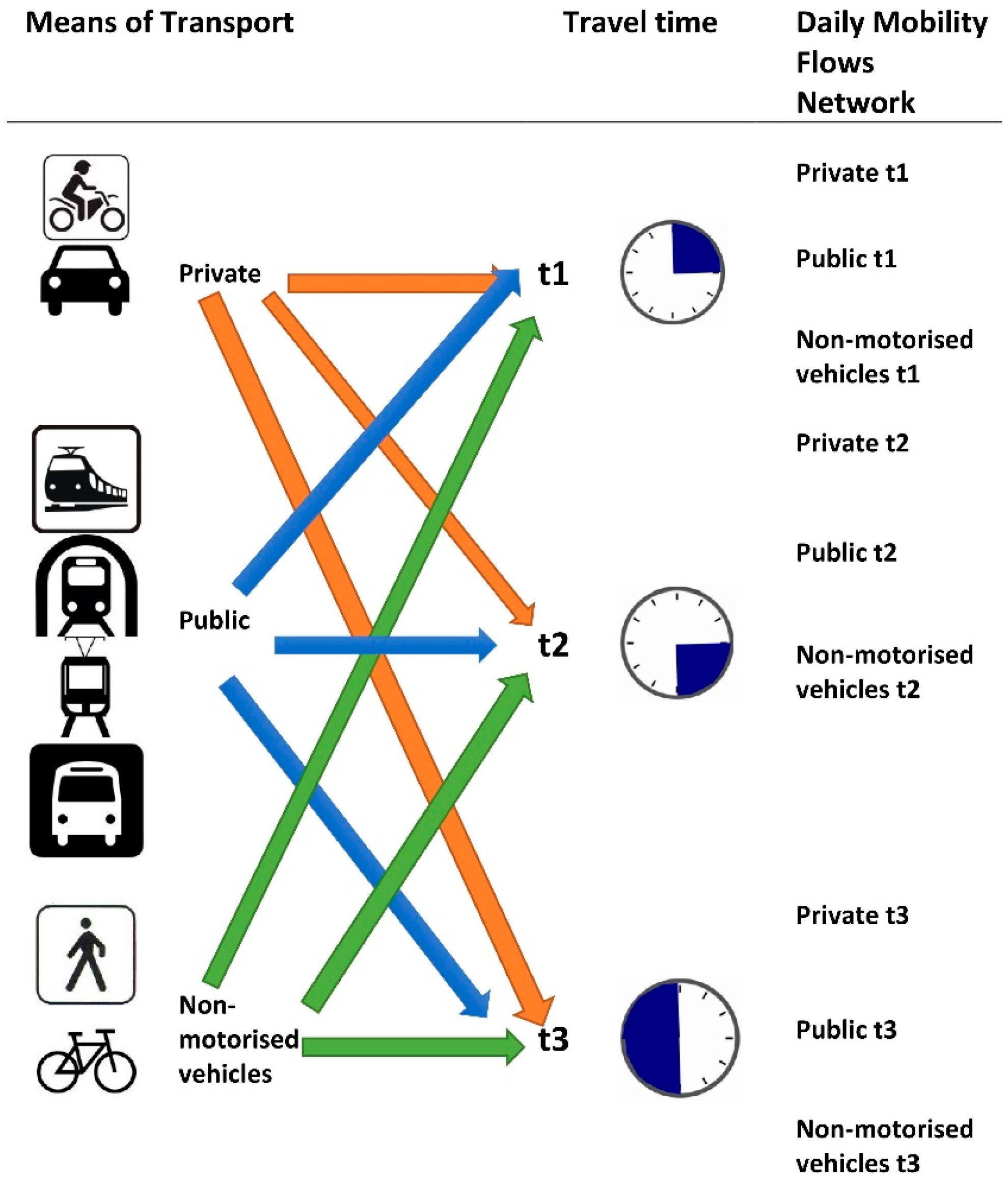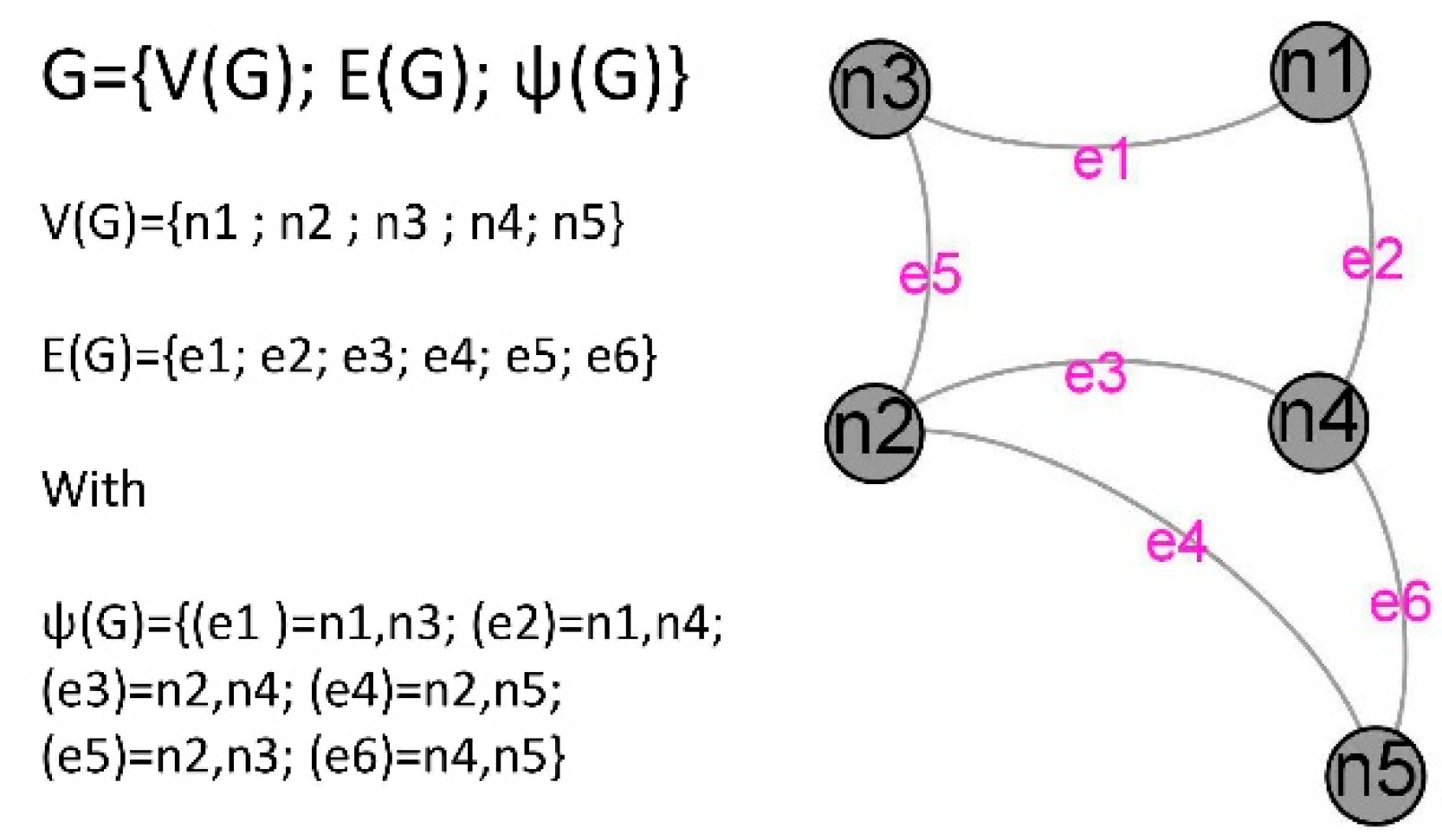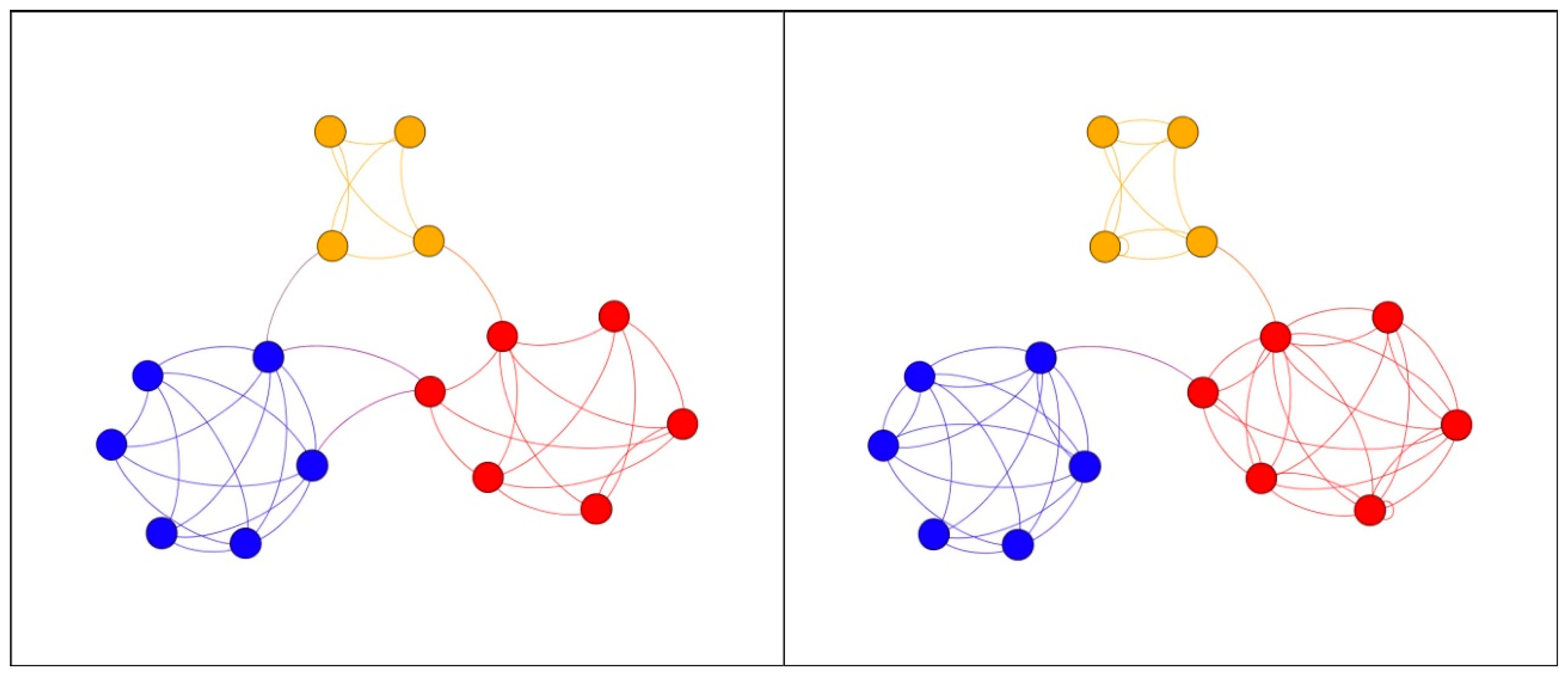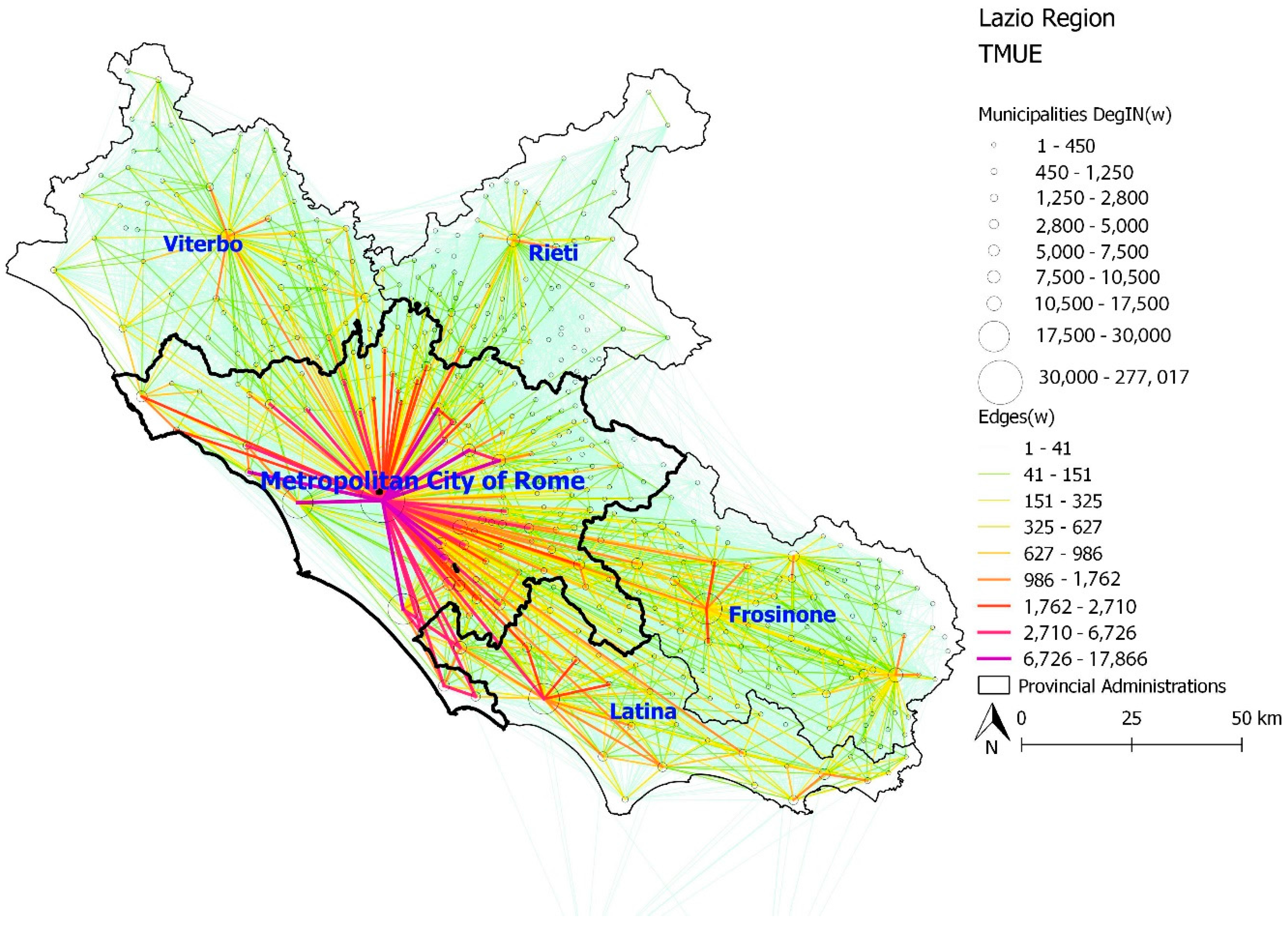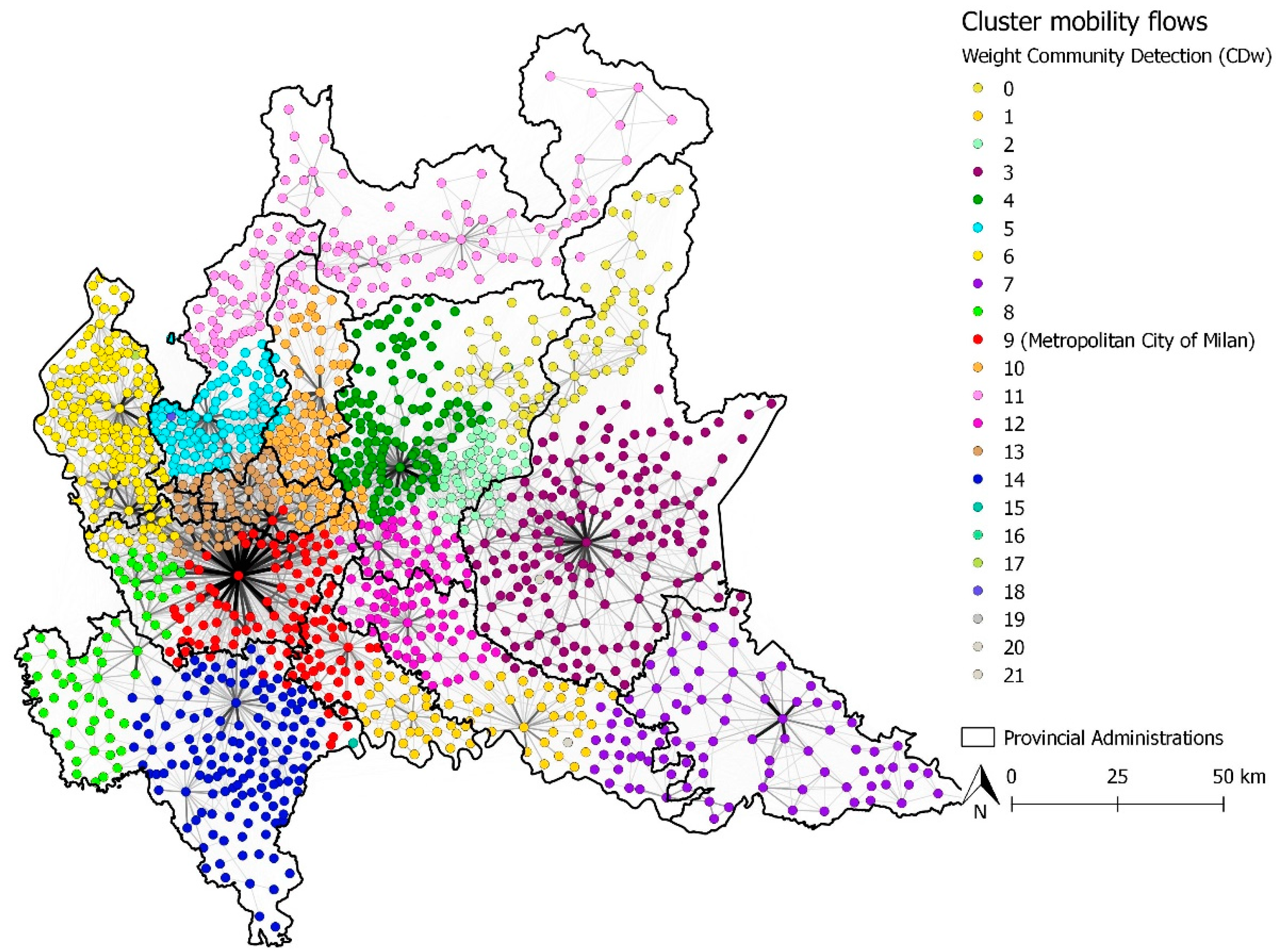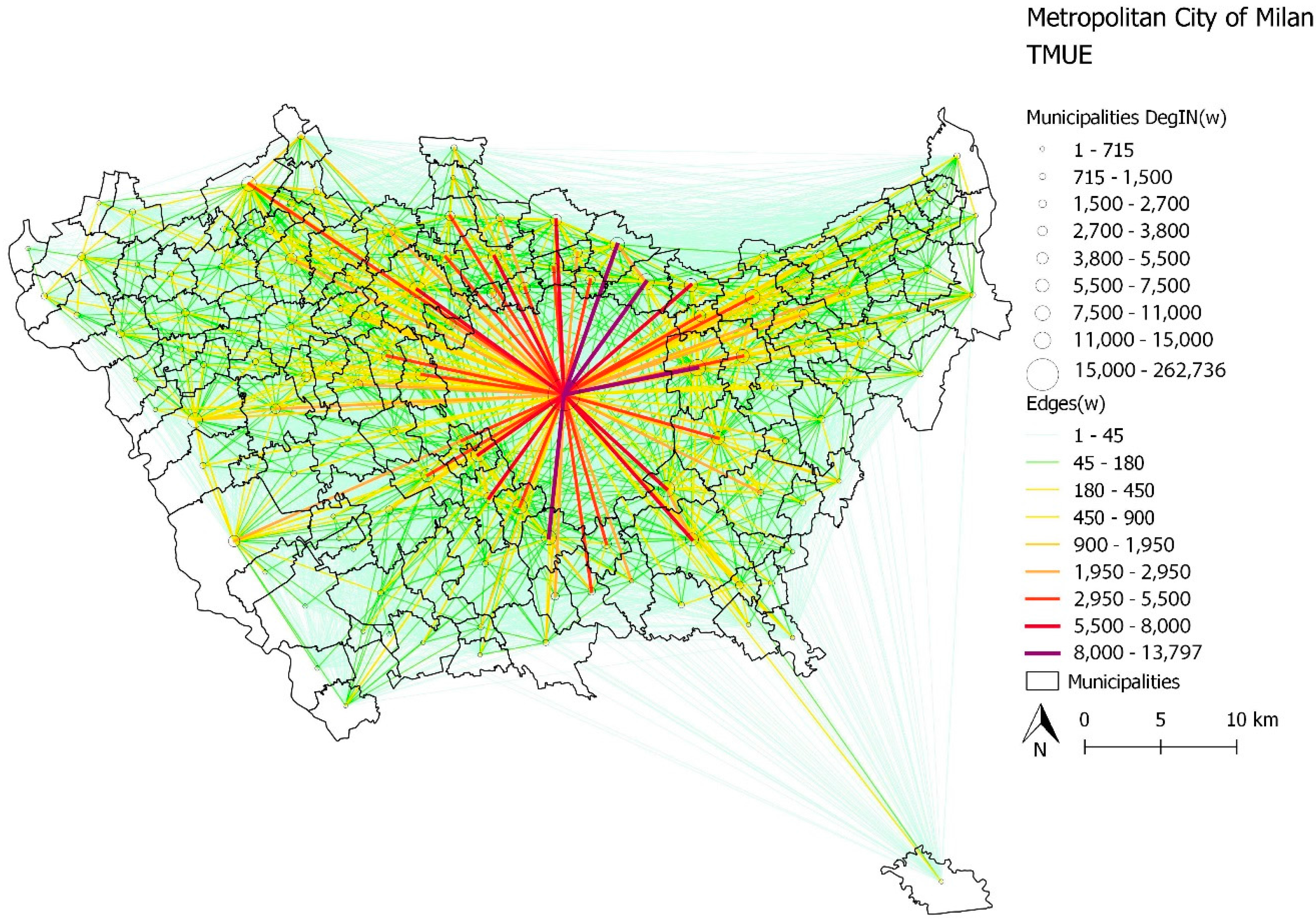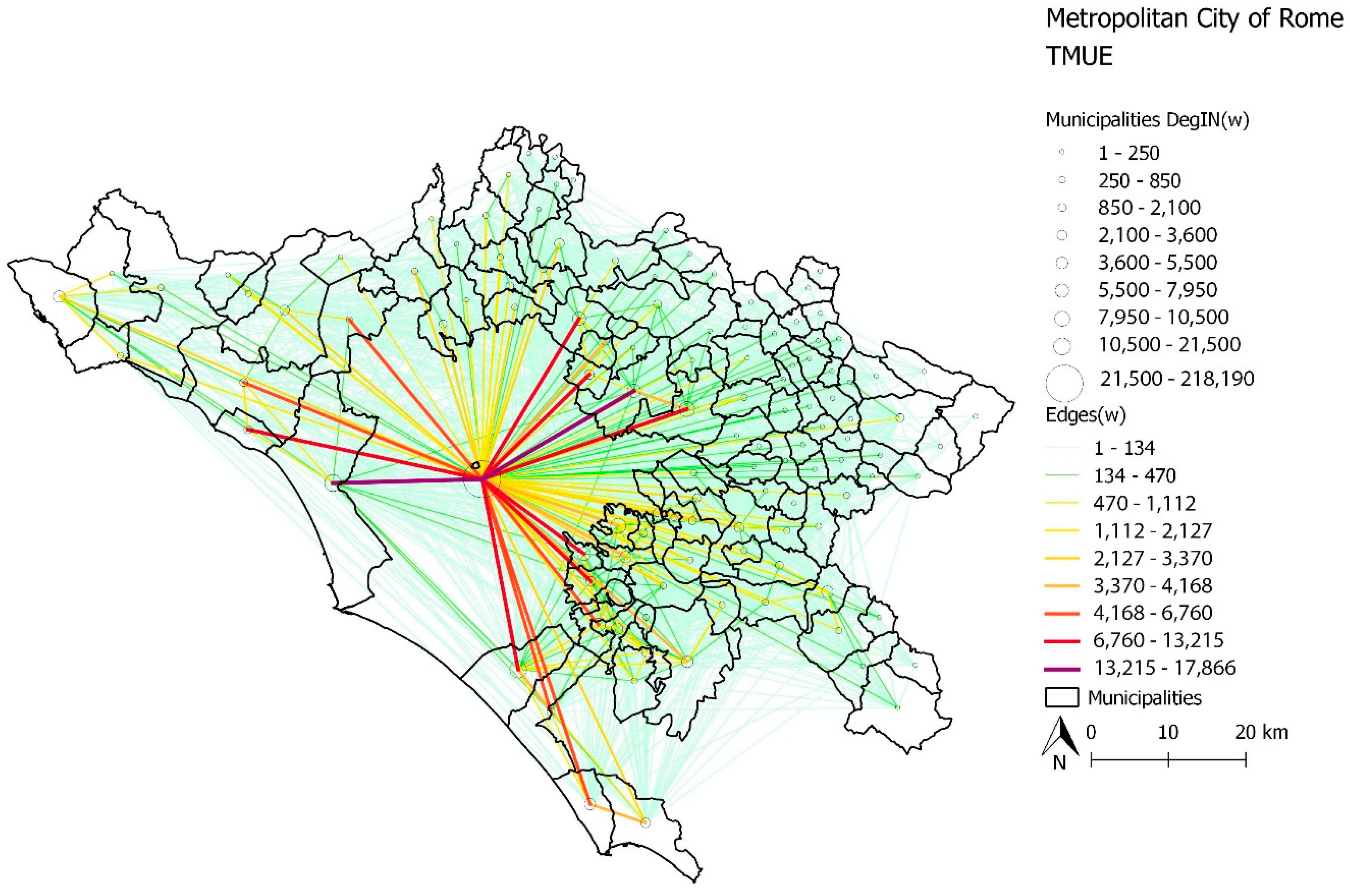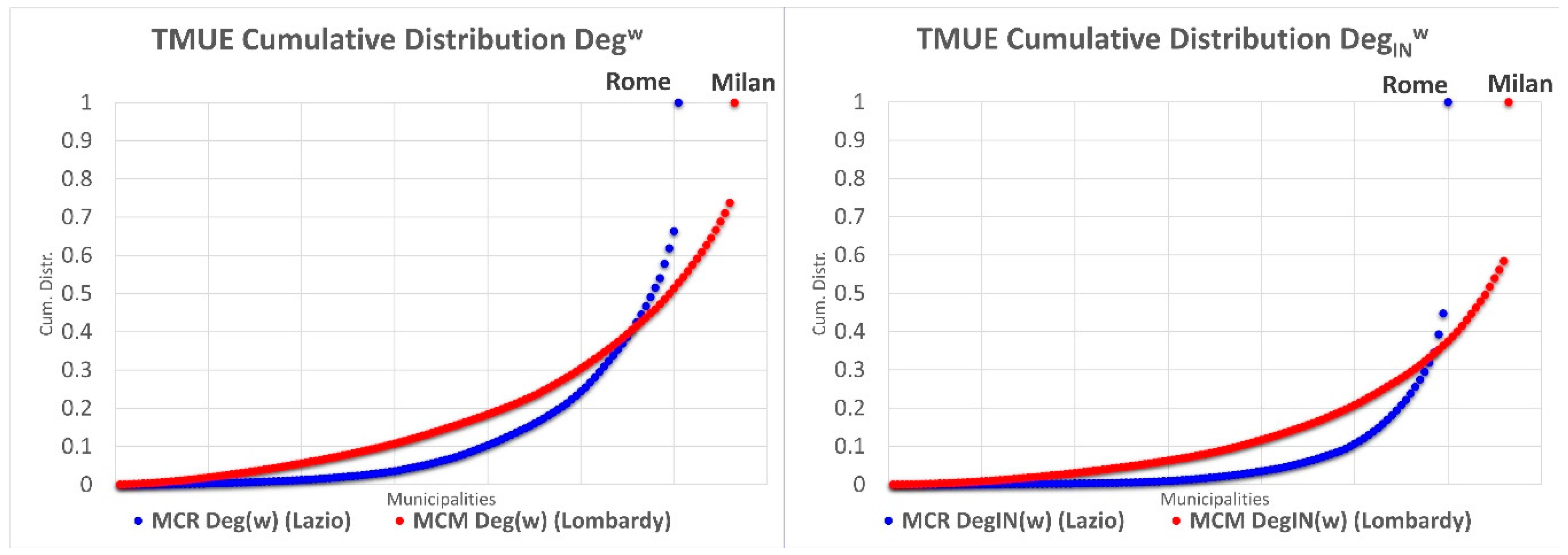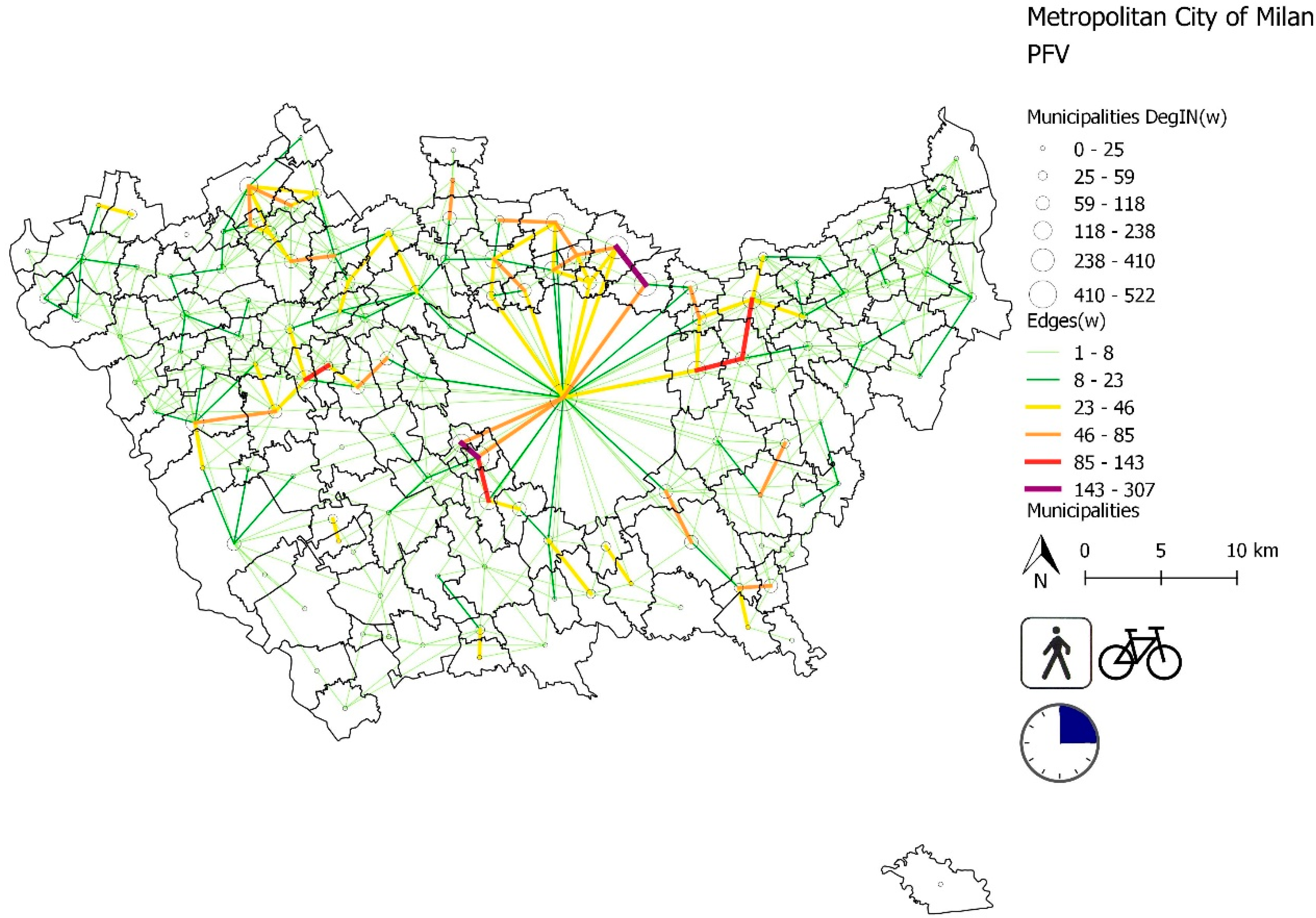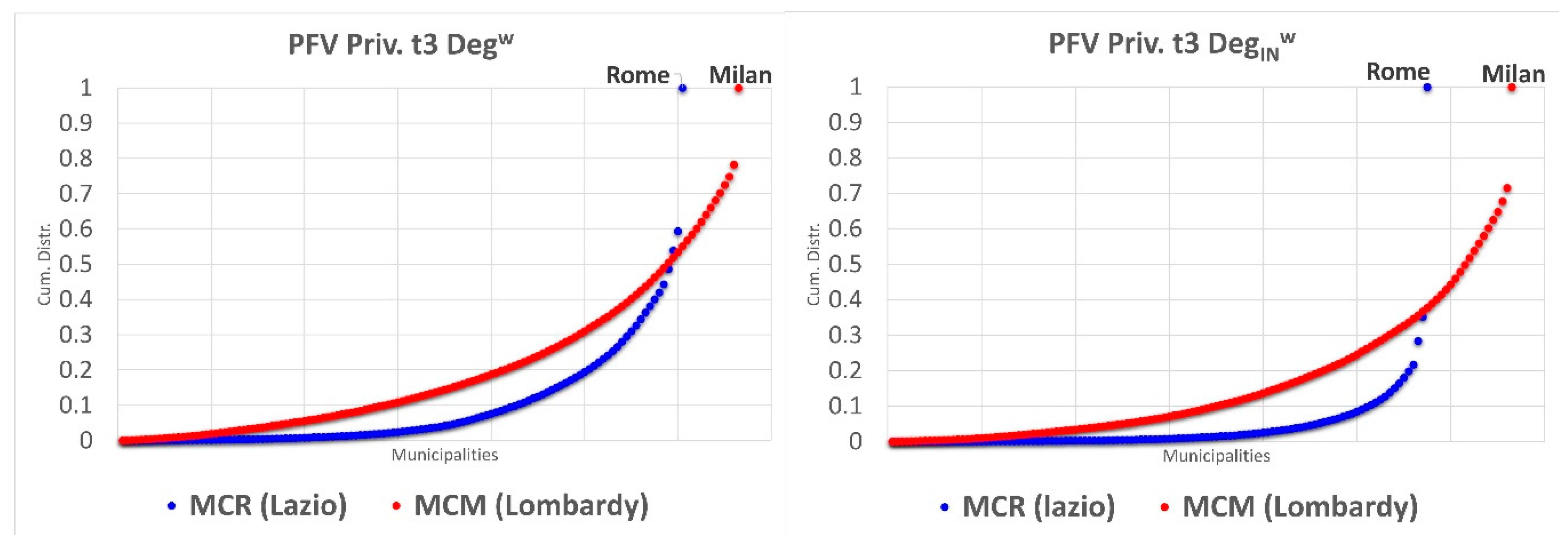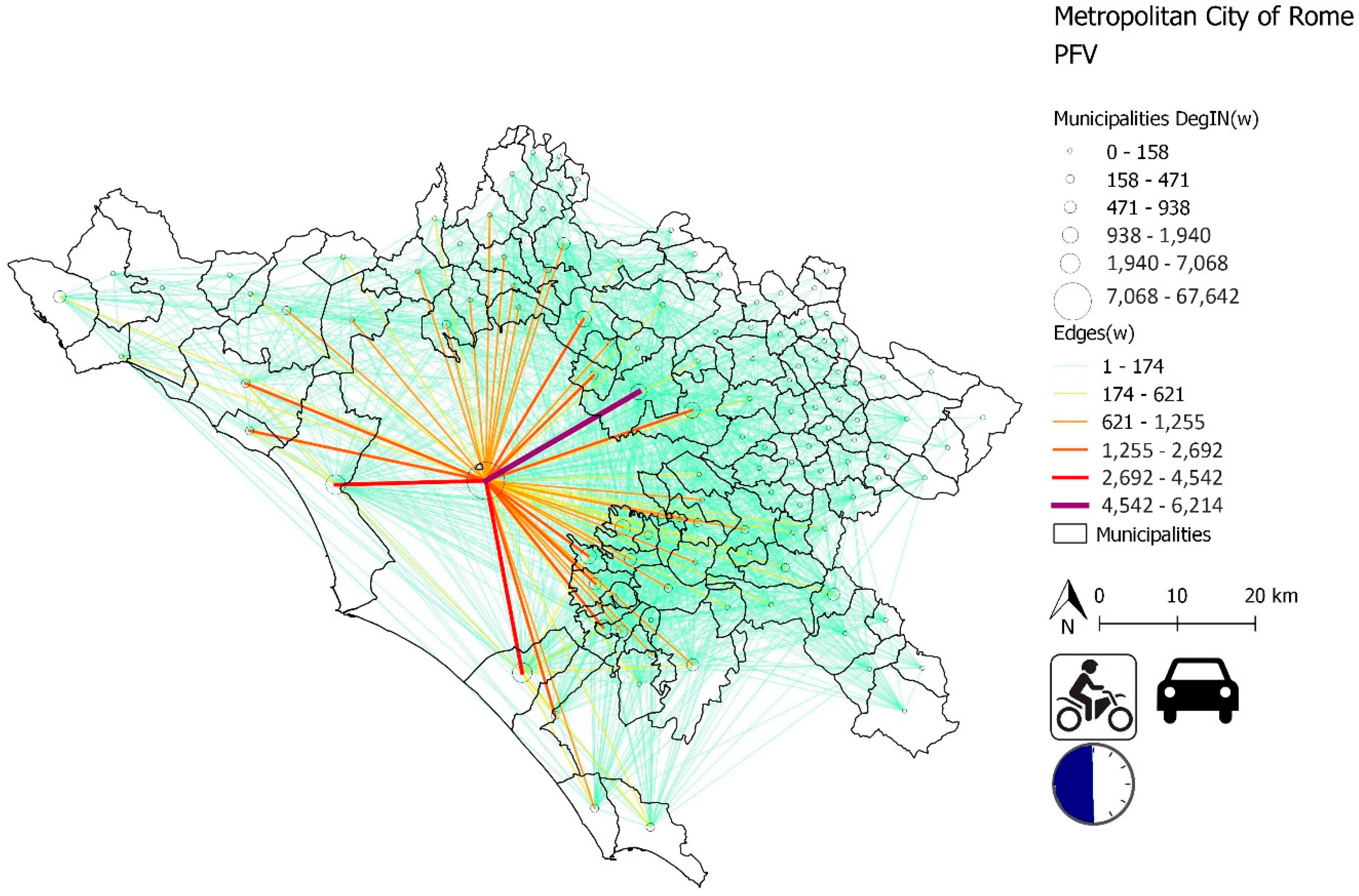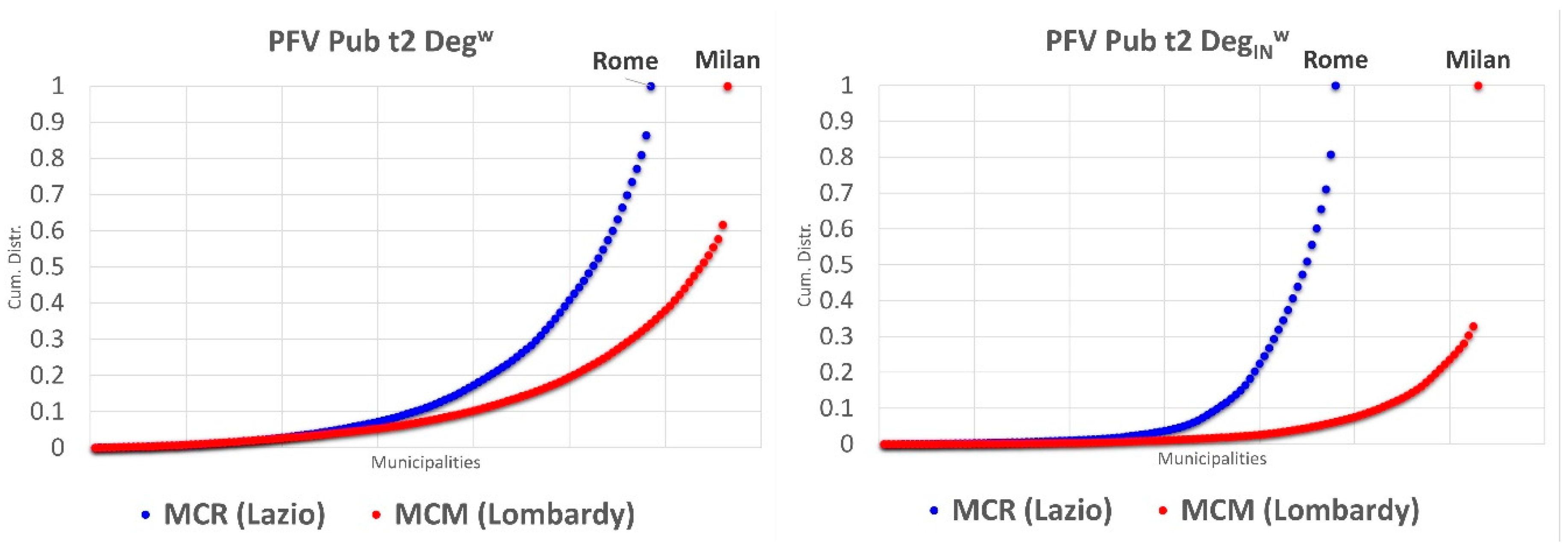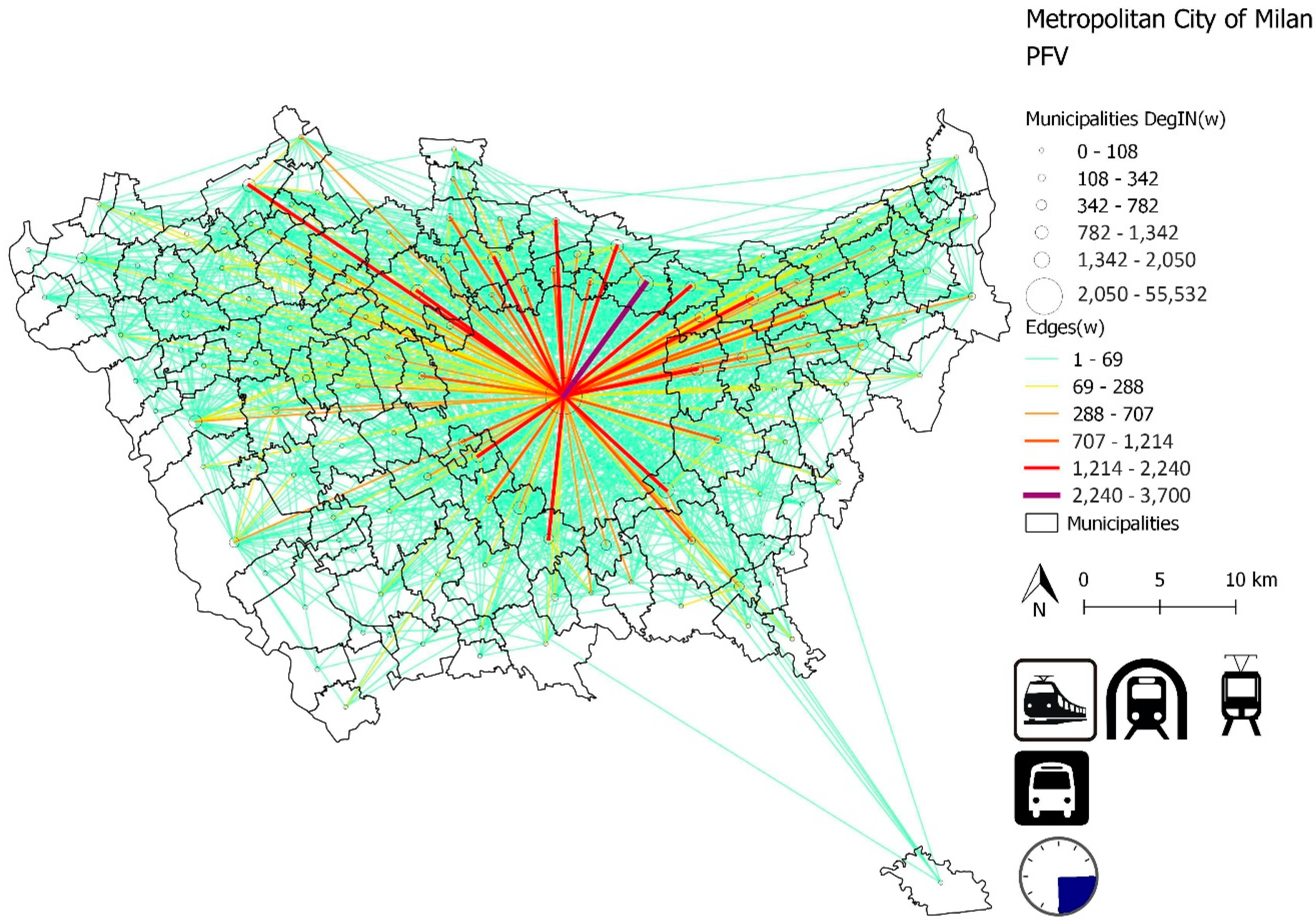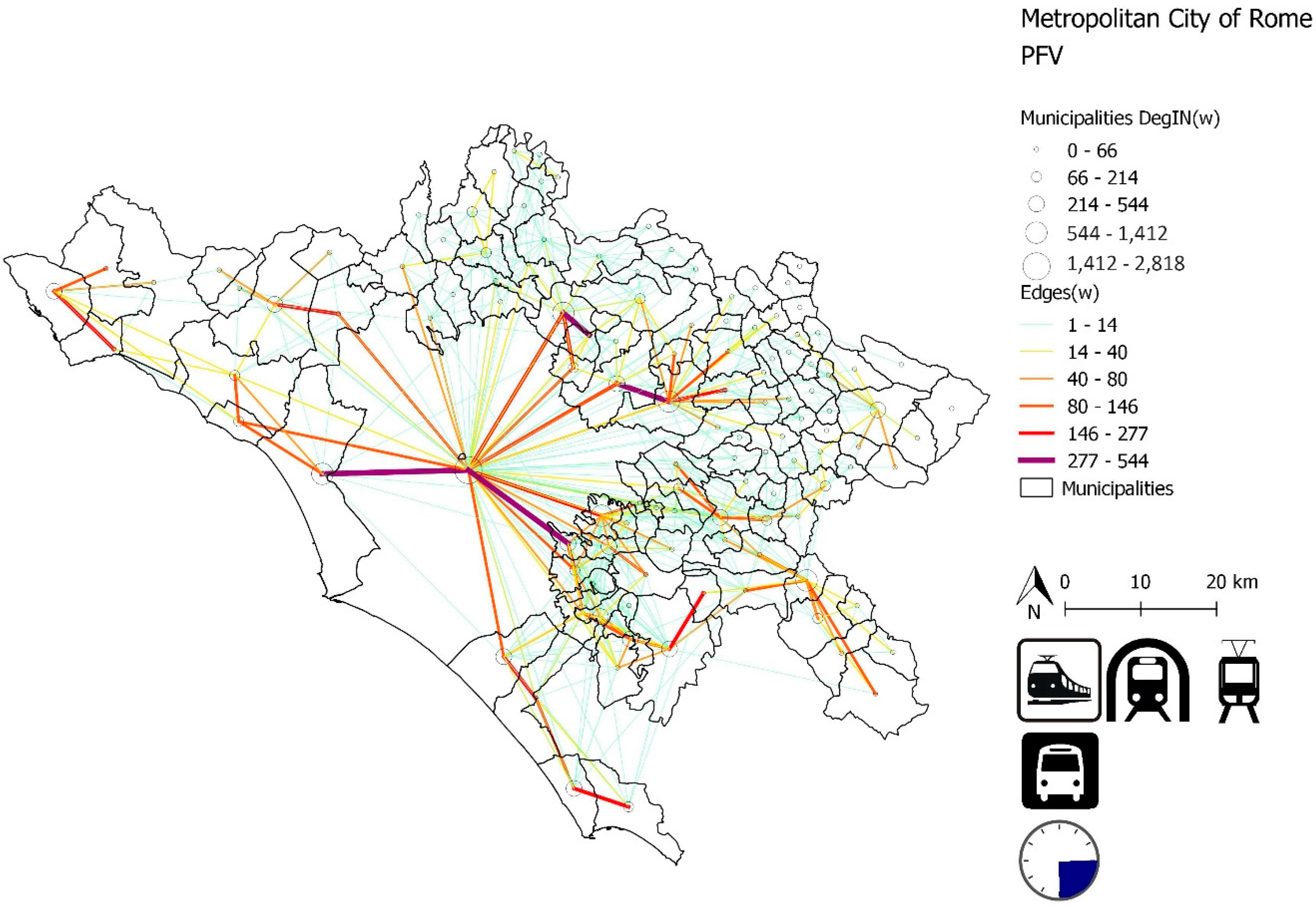1. Introduction
The sustainability of a contemporary city and its evolution depends on the ability of institutions to harmonise resource use, infrastructure, and social investment, and technological development [
1]. To develop policies for the sustainability of metropolitan areas it is essential to identify strategies for the sustainability of nations, continents, and the planet as a whole [
2]. Recent studies show increasing urbanization rates caused by a large-scale population shift from rural and marginalized areas to cities [
3]: in 1800, only 2% of the world’s population lived in urban areas. This percentage rose to 14% in 1900, 29% in 1950, 47% in 2000 and over 50% in 2008 [
4]. It is estimated that by 2050, 70% of the global population will be living in urban areas, which will increase to 100% by the end of the century [
5]. In Europe almost three quarters of the European population lived in an urban area in 2015, and the share is projected to rise to just over 80% by 2050 [
6]. The flows, as generated by new residents and/or city users as in the case of commuting, are the basis of the new economic, political, and social geographies that influence the development of new regional and continental landscapes [
7,
8,
9].
Commuting is an essential part of urban life in modern urbanized areas [
10]. To manage these flows and control the negative effects derived, it is necessary to gain a better understanding of the dynamics that characterise the urbanization process [
11,
12]. Due to the complexity of the phenomenon it seems rather reductive to attribute cities’ attractiveness only to a higher quality of life, better employment opportunities and higher incomes, or the better quality of services such as health and education. The reasons for the “power of cities” contrast with the observed crisis of contemporary metropolises: environmental problems, poor access to resources and services, marginalization, and poverty are in fact characteristics of many contemporary metropolitan landscapes [
3,
13]. Therefore understanding the numerous reasons behind these agglomerating forces is essential for planning, but it is not sufficient for developing realistic planning tools. In line with this, it is also necessary to give form, strength and direction to these centripetal forces. Urban areas contain a wide variety of people, structures, activities, and functions, which interact and influence one another with different intensity and complexity [
14].
The mitigation of undesirable effects, such as congestion, energy consumption, pollution etc. depends intrinsically on our understanding of urban structure, the spatial arrangement of urban hubs and centers, and how the individuals interact with these elements [
15].
Even if there are several methodologies in the literature for studying metropolitan systems that were mainly derived from other disciplines, such as ecology and economics [
16], there is no consensus on the best technique for defining the degree of interaction and geographic edges of the attraction of a city [
17,
18].
The typical model of the industrial city based on a monocentric structure is that it is increasingly replaced by more complex structures, where hierarchy appears to be a less dominant feature. Polycentricity seems to be the new prevalent model of spatial organisation in many contexts [
19,
20]. But, the question of how to assess this aspect is still open. Several authors have studied the morphological aspect of polycentricity, basically addressed on the size of urban centers across territory (gravity models) [
21,
22], while others have taken the functional relations between centers into account [
23,
24].
Several indexes have been proposed to measure centrality (e.g., ratio of commuting flows or employment between the central city and the rest of the city-region; ratio of commuters from other city-regions compared with total employment, in-degree index; degrade of evolvement of a node) and identify sub-centers [
19,
25,
26,
27,
28]. Different methods have sometimes provided different results.
Furthermore, a system may be polycentric in respect of a specific aspect and monocentric in respect of another [
29]. As showed the spatial organisation of the urban network depends on the lens through which it is assessed. In fact, the spatial organisation of each functional linkage (e.g., commuting, shopping trips and inter-firm trade) is not necessarily identical, and, therefore, a region can appear to be polycentric and spatially integrated based on the analysis of one type of functional linkage, but monocentric and loosely connected based on the analysis of another type of functional linkage [
23].
As argued in the literature, it is possible to identify central places in a system by analyzing the way the relationships between cities are distributed within it, rather than the statistical characteristics of the territory [
29,
30]. The conceptualisation of metropolitan areas as networks of cities made up of nodes and links between each node (commuting flows) has led to the use of graph theory as tool for analyzing them. Graph theory is branch of mathematics developed by the Swiss physicist Eulero in the 18th century [
31,
32,
33] to represent relationships between elements. Mathematical models formulated on the basis of graph theory make a description of structure elements possible, as well as the identification of more complicated relations between them [
34]. The graph theory associated with exponential growth in computational capacity offers analysis tools that are absent in other methodologies. With the current technologies and algorithms, it is possible to calculate the reciprocal influence between the different nodes of the network considering hundreds of thousands of relationships, each with different weight and direction [
35].
In the recent decades, the algorithms based on graph theory have been applied in numerous research fields related to the analysis of complex dynamic systems [
36,
37], such as interactions in economic and social systems [
38,
39] and infrastructure and transport [
40,
41,
42], applications in urban and territorial planning [
43,
44], and for the analysis of ecological systems [
45,
46]. In particular, the algorithms based on graph theory are proving to be highly adaptable for analyzing commuting flows [
47,
48,
49,
50,
51] and prove to be effective tools for evaluating changes in new urban geographies, as well as provide more clearly readable results.
Moreover, these algorithms have been used both for large metropolitan areas and for small to medium sized cities with different spatial patterns [
52].
Although commuting flows are well known, the study of their networks from a graph theory perspective in Italy remains relatively limited.
Today, more than ever before, flow and mobility management issues are some of the major themes and challenges that urban and territorial planners face [
53]. In its various forms and connotations, mobility is a dominant phenomenon of contemporaneity that has enormous consequences for urban systems, the quality of life of the inhabitants, environmental conditions and economic development and can provide useful insights into the physical spatial structure as determined by economic and social interactions [
54,
55,
56]. In fact, as argued by some authors, mobility produces the greatest impact in fragmented and dispersed urban systems [
55]. In particular, it has been observed that public transport loses in terms of efficiency and competitiveness as urban fragmentation increases when compared to the use of private transport. The latter, instead, does not seem to be directly related to the size or shape of the city as to wealth and the emergence of new lifestyles.
Expressed in another way, the studies on new urban geographies that were carried out with flow-through analysis are a result of the deep demographic, economic, and social changes, and the emergence of systems of interrelationships, metabolisms, and mechanisms that involve larger and more complex territories, which have local and global implications. With flow-through analyses, it is possible to measure the interdependence between the different parts of a metropolitan system by computing the demand for access to sites, services (such as health, education), and activities that are located in the territory (such as housing, work, shopping).
In this study based on commuter census data [
57], various flow networks (for time shift mode) in two main Italian metropolitan areas, Rome (MCR) and Milan (MCM), were constructed and analyzed using graph theory.
The network analysis provided information on the dynamic processes occurring in these two urban macro-systems, on the forces of attraction that mother cities (as dominant cities able to influence surrounding territory and to attract important flows from it) have on daughter cities and the territories they depend on for the supply of resources and energy. In particular, the study focuses on the following aspects: (i) the identification of the characteristics, distribution and direction of the major attractive forces of the cities within the vast regional systems in which they are located; (ii) the identification of the main differences in the size and structure of commuting networks between the two metropolitan areas and between the two regional systems including the two mother cities; and, (iii) the identification of the main differences in the size and structure of the different commuting networks by transport modes (private, public, non-motorized mobility) and travel time.
In the first part of the paper we describe the two case studies (MCR; MCM), the data and the data analysis method used. We will then illustrate and discuss our results, and finally, we will draw some conclusions and propose directions for future research.
Case Studies
Metropolitan areas are defined by assessing the degree of functional integration between parts of the territory. In the Italian national context, the metropolitan issue refers to the consolidation of asymmetric interdependence between contiguous municipalities, where asymmetry is given by the presence of a larger municipality than the others whose forces of attraction structure the surrounding territories [
53]. The “metropolitan areas” pursuant to art. 118 of the Constitution of the Italian Republic have undergone a major administrative-functional reorganization following the issuance of National Law 56/2014 (“Delrio Law”). In fact, this law established that the major Italian provinces should be replaced with Metropolitan Cities (MCs) as new government authorities in large urban areas. They are second-level institutions that are politically and functionally connected to the municipalities of their district. The “Delrio Law” established 10 MCs in Italy: Rome, Turin, Milan, Venice, Genoa, Bologna, Florence, Bari, Naples, and Reggio Calabria, excluding the regions with Special Statutes (Friuli Venezia Giulia, Sardinia and Sicily) (
Figure 1).
Overall MCs cover less than 20% of the national territory and affect less than 20% of the municipalities. However, almost 40% of the Italian population resides in them (
Figure 2).
MCM and MCR are certainly the two most economically influential metropolitan areas in the national context [
3] (
Figure 3).
The MCM is a densely populated area (2.042 pop/kmq) with more than 3,000,000 residents [
56] and almost one-third of the regional population. The area is composed of 134 municipalities, covering approximately 1500 square kilometres; it produces about 12% of the Italian Gross Domestic Product (GDP). 84 percent of the added value produced by the Milan economy derives from services. Also, at the occupational level, the preponderance of services emerges when compared to other production sectors in the Milan area. Over the last 20 years, the core of the city and all of the urban areas has undergone profound spatial and structural changes that have created new relationships between the center and the suburbs. The municipality of Milan is currently the heart of a large urban system that integrates numerous municipalities according to a geography in which the ex-provincial territory is an important part of the system but not the whole.
The MCR is composed of 121 municipalities that previously belonged to the province of Rome. The areas cover approximately 5300 square kilometres with a total of approximately 4,000,000 residents, and the density is 812 pop/kmq [
57]. The economic productivity of this area is slightly lower than in the MCM (approximately 9% of Italian GDP). In Rome, there are concentrated service companies (especially the services for companies) that operate at national level, thus determining a specialization in the tertiary of the economy. It should be noted that the data is largely determined by the significant presence in Rome of the Administrations Power stations that alone contribute to the production of 20% of the added value. The metropolitan area is less densely populated than the MCM, with a weaker urban production system and a dispersed settlement pattern.
2. Materials and Methods
The data used in this study were extracted from the National Commuting Matrix (NCM) and collected during the 15th National Population Census by the Italian National Institute of Statistics (ISTAT) [
57]. For NCM realization, ISTAT interviewed 28,871,447 citizens who commute daily between their residence and their place of study or work. Their responses have been elaborated and inserted in a database and then aggregated for homogeneity of information about the Municipality of Origin and Destination, type of transport and the time needed to reach the destination. The database (DB) was composed of 4,876,242 records. In the database, alphanumeric “tags” were used to classify the information on the daily habits and needs of the citizens. For this analysis, the information contained in the NCM was filtered and then aggregated using the following variables: transport modes (means of transportation used by the commuter), duration of trip (travel time from origin to destination), and departure and arrival municipalities (
Table 1) (origin and destination).
The NCM was filtered through an Open Source Database Management System (DBMS): PostgreSQL © (
https://www.postgresql.org/), by only selecting the records corresponding to the two Regions under study from the matrix, according to their Regional ISTAT code (Lombardy = 03; Lazio = 12). Subsequently, the records corresponding to the two AMs were filtered through the ISTAT provincial codes (Milan = 03015; Rome = 12058) by applying a new query to the result of the previous selection. This study only analyzes inter-municipalities commuting, therefore the records with values 01 and 03 for “Destination of the trip” were deleted from the four previously obtained commuting matrices. In short, four matrices (two for the regions and two for the MCs) were extracted from the NCM general matrix and were filtered in order to analyze only inter-municipalities commuting occurring within the administrative boundaries. On the basis of this information, we built different (for movement modes and times) commuter flow networks.
Firstly, we analyzed the four general matrices in the form of a graph in order to obtain four general networks, where commuting flows between municipalities is the sum of all daily travelers who use any means of transport with an unspecified duration of trip to commute between them. This value known as the “Total Moving Unit Estimator” (TMUE) (that is the total number of commuters that every day from home and using any means of transport with an undefined total travel time, even 24 h, reach their place of work) is calculated as:
Subsequently, for the two metropolitan areas, the analysis was deepened by building specific commuting networks according to transport modes and duration of trip. In other words, a partial flow value (PFV) was calculated according to the means of transport used and the time required for the displacement.
To this aim, the various categories of “Means of transportation” were aggregated in three macro-categories, according to their typology: (A) Private vehicle; (B) Public vehicle; and, (C) Non-motorized mobility. The first macro-category includes the typologies indicated by codes 07 to 09, the second includes codes 01 to 06, while the third includes codes 10 and 12. Category 11 (Other) was excluded from the analysis, as it was not properly specified.
For the “Time” variable, we considered categories from 01 to 03. Category 04 was excluded due to lack of accuracy. Therefore for each of the two metropolitan areas, 9 PFV networks were built (
Figure 4).
The networks were analysed using Graph Theory Algorithms. Graph Theory is a branch of mathematics developed by the Swiss physicist Eulero in the 18th century [
31,
32,
33].
A graph is a mathematical structure for representing relationships (
Figure 5). It is composed of nodes and edges, in which the nodes indicate elements and the edges indicate relations between nodes [
58]. More formally, we can define a “G” graph as an ordered triple, which is composed of a nonempty set of nodes (n) designated as “V(G)”, a set of edges (e) designated as “E(G)” disjoint from “V(G)”, and the relations (Ψ) associated with each edge that connects two nodes [
59]:
In our analysis the nodes represent the municipalities, the presence of an edge between two nodes indicates the existence of a commuting flow between them, the magnitude of this flow, that is the number of people moving between two municipalities (TMUE or PFV), is a property associated to the edge as weight (w). There are many types of graphs that differ by type of structure, relationships that connect nodes and other features [
58]. The graphs that are associated with the different networks analyzed in this study are geometric, weighted, and oriented. A graph is oriented when an automatic reciprocity of the flows between two Municipalities (i;j) cannot be acknowledged, for which the following relationships apply:
This is because not all of the municipalities have both incoming and outgoing flows. Furthermore, even if both flows exist, the number of commuters that are travelling in each direction may not be equal. In order to determine the importance of nodes, the distribution characteristics of the graphs and their articulation on the territory, we used the main centrality measures at the various scales of analysis; for the regional level, we also carried out the Community Detection (CD) analysis and identified the relative modularity value (Q) (
Table 2).
In particular, the first measure concerns the weighted degree (Deg
w) of the node. This value is often identified in literature by the “k” symbol and it is the sum of the weighted edges thag are connected at the node considered [
58,
59]:
This represents the total number of inbound and outbound commuters from each network node (municipality).
When considering the previous three expressions on the direction of the flow, it is possible to split the (Deg
w) into two components: the In-Degree (Deg
Inw), which is the number of people entering into each node, and the Out-Degree (Deg
Outw), which is the number of commuters leaving their municipality of residence on a daily basis.
Density (Δ) and Diameter (Φ) are two structural measurements. They express some general properties of the graph [
60,
61]. The first is a measure that enables us to evaluate the connectivity of the structure and takes into account the degree of centralization, multiplicity, and the diffusion of links within the network by correlating the actual number of edges present in the network at time “e
t” to the maximum number of arcs potentially possible at the same time (t) if each node (n) is connected to any other network node (n − 1).
Density assumes a value between 0 and 1; where 0 indicates that all of nodes are isolated, 1 is the maximum density possible. The distance d(G) between two nodes “i(V)”and “j(V)” is the length of the shortest path that connects them [
62]. Diameter (Φ) indicates the shortest path between the pair of nodes (i;j) that are farther away from each other in the graph.
For the regional networks, we carried out an analysis of sub-reticular structures (Community) in order to identify composition, characteristics, and geographical location (Community Detection) (
Figure 6). These sub-structures are identified in many scientific areas, for example, in social sciences, with the aim of identifying ethnic and religious minorities [
36], or in the analysis of bibliographic networks for highlighting groups of articles or authors who cite each other more frequently [
39]. In this analysis, the identification of the Communities provides us with valuable insight on the territorial extension of the influence or attraction force that “mother cities” have over the surrounding area. In literature, there are numerous procedures for identifying communities, which can be classified into three large families [
63,
64]: divisive methods, spectral analyses, and methods that are based on modularity optimization (Q). Optimizing modularity involves dividing a network into several sub-structures so that the gap between the number of edge connecting nodes belonging to the same community and the linking nodes belonging to different communities is as wide as possible [
58].
The value of modularity is generally expressed as [
36]:
where “K” is the degree of the nodes, “m” is the number of the edges of the graph; “a
ij” identifies the edge in the adjacency matrix; the δ function assumes value 1 if vertices i and j belong to the same community, otherwise 0. Its value may range between 0 and 1, where 0 indicates poor clustering and 1 means that the clusters are well separated. Results vary considerably according to the algorithm used and the parameter “γ” which expresses the value of its resolution [
65]. In our study, we used the Louvain algorithm [
66] for the execution speed that reduces response times even in networks with thousands of nodes and links.
Our CD analysis also considers the weight of the edge (w
ij). In this case however, in line with the literature on gravitational models, the assumption is that the influence between two nodes increases as the commuting flux increases and decreases as the distance between them increases [
17].
The analysis was carried out on open source platforms: QGIS® for the geographic part and Gephi © for specific analysis of the network properties.
4. Discussion
In the Lombardy region (Milan), commuting is a more widespread daily phenomenon with a greater number of individuals involved and a major number of exchanges (edges) between the towns of the case of the Lazio region (Rome).
However, in the Lazio region, a denser network of commuters was observed than in the case of Lombardy, due to the fact that there are fewer municipalities.
Initially, this result may appear to be due to the difference in the number of nodes that are analysed in the two cases, which partly explains the results on the density and diameter of the regional networks.
However, the most important indications on the morphological differences in the two metropolitan systems can be obtained from subsequent analyses on communities and the value of their modularity (Q). This value highlights the presence of numerous widespread urban settlements within the Lombardy region with a high ability to polarise flows, leading to the fragmentation of the regional network into 22 communities.
Contrastingly, in the Lazio region, the smaller number of substructures and lower quality of clustering can be explained by two factors: the presence of the mother city of Rome, which is able to attract substantial flows even from the peripheral municipalities of the region, and the absence of other large urban centers that can contrast this capacity.
Expressed in another way, the results of the analysis seem to indicate the existence of a wider regional city with a functional polycentric organisation in the Lombardy region, where the MCM is definitely the most important component, but not the only one; while, the Lazio region has a monocentric nature thanks to the city of Rome, which develops attractive capacities throughout the whole region. This means that even if, as many authors argue [
19,
67], the polycentric model is becoming a typical contemporary from of urban systems’ organisation, a monocentric typology persists. This is not necessarily good or bad per se. Some authors have highlighted the advantages of polycentric systems [
29,
68,
69], with respect to monocentric systems, but there is not a consensus about that [
29,
70]. The polycentric nature of the MCM and the monocentric nature of the MCR found in this work are consistent with other studies on the two areas through with other methodologies and different types of data [
25,
71,
72].
These considerations are confirmed by the analysis at the metropolitan scale and by investigating the influence of the two metropolitan areas on their metropolitan system.
In Lazio almost 60% of the entire regional flow is focused on the MCR and over 50% of this flow converges upon the city of Rome; while less than 25% of the entire regional flow is focused on the MCM and the city of Milan attracts approximately 40% of all the incoming flows.
The cumulative distribution DegINw curve of MCM shows the presence of many other centers with high attractiveness. This trend is not present in the MCR where the cumulative distribution is much flatter along the horizontal axis.
The analysis of the network according to transport modes and travel time shows numerous differences as well as some similarities between the two metropolitan morphologies. In particular, they are similar in respect to the use of private vehicles. This result is in line with a general national and international trend [
73], which is partly explained by the diffusion of a new form of living and new of forms of settlement [
74], but also by the lack of adequate policies, investments, and interventions [
75,
76,
77]. However, the networks created and the weight (attraction capacity) of the two mother cities within their respective urban systems are very different.
The hypothesis of MCR monocentrism vs. MCM polycentricism is also confirmed by the analysis at the metropolitan scale.
The strength of the city of Rome prevails sharply within its metropolitan city, dominating the incoming flows during the two periods (t2, 16 ÷ 30 min and t3, 31 ÷ 60 min), while in the MCM the strength exercised by Milan is limited by the attractiveness of other urban centers. Contrary to these results, we notice that an opposite trend was observed for the “t1” (0 ÷ 15 min) interval as Milan clearly dominates its territory. This result is consistent with that stream of the literature arguing that polycentric systems are characterised by a reduction of time spent on travelling [
52], but in contrast with the other stream arguing that polycentricity does not seem to influence the time spent on travelling in significant way [
29].
This result provides valuable insight into how variations in the intensity of a mother city’s attractiveness change not only in terms of transport modes but also in regard to the temporal variability considered. These changes can be reasonably assumed to be cyclical and similar over several days. Therefore, it seems reasonable to state that the metropolis “breathes” (somehow recall a person’s lungs dilating and contracting), that is, its strength is not static as it can increase and decrease.
In both areas of analysis, the propensity toward non-motorized mobility appears limited in proportion to the total flow, even if it is higher in the MCM. This latter aspect confirms what some scholars have observed in different polycentric areas [
78], probably thanks to a minor distance travelled. Moreover, in the MCM it was observed that commuting flows preferring non-motorized mobility create a larger and more articulated reticular structure.
Regarding public transportation, the city of Milan emerges as a powerful attractor. In fact, it attracts almost 70% of metropolitan area DegINw of the “t2” travel time (16 ÷ 30 min).
The density and diameter measurements of the network indicate that this is more compact and dense in the MCM than in the MCR, yet it is essential to interpret these results bearing in mind the time lag of the peaks in the two metropolitan areas.
It is important to note that in the MCM the largest commuter flow occurs in the “t2” travel time (16 ÷ 30 min), whereas which it occurs in the “t3” (31 ÷ 60 min) in the MCR.
It should also be considered that a large number of Roman commuters, almost 25% of the total of all types of flows, take over an hour to reach their destination, while this is only the case for less than 10% of Milanese commuters.
5. Conclusions
In this work, we used graph theory to analyse the commuting flows in two Italian metropolitan areas with the aim to increase the knowledge about them as support for the future develop of transport planning. In particular, in this research, the directionality and intensity of commuter flows have been used to calculate the extent of influence of the metropolitan areas by identifying clusters through CDw and identifying portions (Community) of network, in which the relationships between nodes are maximum and at the same time minimal with nodes of other portions of the network.
The study demonstrated the validity and potentiality of using graph theory for understanding the growing complexity and dominant dynamics that draw contemporary metropolitan landscapes. As already observed in other European and non-European cities [
19,
79], the metropolitan areas and the large regional systems analysed in this study show an accumulation of resources in mother cities and an important commuter flow that has to travel daily to reach services or workplaces. In line with previous research the analysis describes the ability attraction of cities on the surrounding territories. However, the research results show significant differences between the phenomena that are considered.
We identified the territorial basins of each large urban center, to determine the differences in the behaviour and articulation of flows within the two regional systems. In particular, the analysis highlighted the differences in the morphology and attractiveness of the mother cities of the two metropolitan systems bearing transportation modes and travel times in mind.
This study also highlighted how the modulation of this strength changes, stretching and contracting, over different periods of time. The need to reduce air pollution and damage to the environment and public health and to improve the quality of life, travel and social equity has placed sustainable accessibility and mobility in first position in the most recent policies, both at the national (PON 2014–2020, Strategic Plan for Metropolitan Cities) and European levels (European Policy Agenda, EU Transport White Paper 2001, Urban Mobility Package 2013). In this sense, the future of the sustainability of the metropolises strictly depends on an understanding of the complexity of the phenomenon, to which this study contributes.
Flows analysis is therefore an essential instrument for interpreting territorial models and can be used to foresee present and future settlement processes. The ability to develop investigation tools and methods capable of effectively analysing and measuring problems, dynamics, and changes with regard to mobility becomes strategic.
The findings of our work many have a role in transport planning and in the evaluation of policy aimed to favour more sustainable mobility in the studied areas. In fact, our analysis provides detailed measurements of commuting networks in the MCs of Rome and Milan. Having a solid knowledge of these it is indispensable for the individuation of critical points, goal planning, and prioritising of projects, as well as policies ex post evaluation. Obviously, to do this we need to analyse other aspects and other census variables. The next step might be gaining a deeper understanding of the human motivations and processes behind the patterns identified.
Among others, future research should focus on the following:
analysing the offer (infrastructure and mobility systems, hardware and software for urban displacement) and interdependencies—feedback reports with demand. It is evident that the offer in terms of the existing infrastructure network and transport lines influence the flow of traffic; and,
identifying concentration flows (and therefore people, means, resources) for prioritising interventions by favouring the use of non-motorized mobility and green transport modes. This is an objective that requires both an assessment of the possibility of creating a network of sustainable capillary connections (pedestrian cycle paths) that can direct the flows towards the public transport network (preferably train) and discourage the use of private vehicles.
